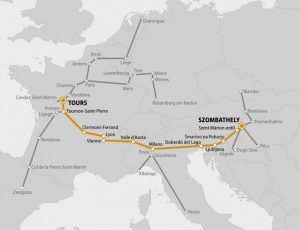Hungarian El Caminos, Pilgrim routes in Hungary

In the recent years religious tourism seems to be in fashion, because more than 300 million people visit important sanctuaries in the world. Pilgrimage is attractive because of spiritual experiences, exercise, fun or the original reason: finding religious meaning in life. Hungary also has routes that are for these reasons, and they show some development in many senses.
Csupasport.hu‘s article, the page cites Eger University of Theology’s director from his professional study: “In the recent years pilgrimage has become more popular, but in many of those cases it is more about something called religious tourism, than real pilgrimism. (…) Pilgrimage is the symbol and reality of breaking up with daily life, because the pilgrim ‘dies’ for subsidiary things and pursues the real reasons of life. (…) Pilgrimage is the school of prayer…” – he says. So, the church is not quite satisfied with motives of pilgrims, but seems like cannot do too much about these tourists.
Dailynewshungary.com gathered you the most-known pilgrim routes. Here they are:
Mária route: (Mária-út)

Started as a route: 2007
This route runs in Middle-Europe shapes a Christian cross, runs through Hungary as seen on the picture both horizontally and vertically.
From East to West direction: Csíksomlyó (Romania) – Máriapócs (Hungary) – Budapest (Hungary) – Mariazell (Austria). Makes a total 1305 km.
This route is walked more by Hungarians, and its starting point, Csíksomlyó makes a huge patriotist feeling in Transylvanian Hungarians, Szekelys. More than hundred thousand Szekelys gather every year at Pentecost.
North-South route is: Czestochowa (Poland) – Esztergom (Hungary) – Budapest (Hungary) – Medugorje (Bosnia Herzegovina). This is about 1400 km (870 miles). Both of these pilgrim paths are about 55-60 days to walk all the way.
Hungarian pilgrim route (Magyar zarándokút):
It started in: 2011. This route is recommended to walk from March to November each year, on any starting day. Pilgrim accommodations put you up cheaper, if you have a ‘Pilgrim passport’, which you can buy in some spots of the country. This is 431 km (267 miles), and it goes from North to South, having 17 sections. Starting point is Esztergom, other main points are: Budapest, Szigetszentmiklós, Ráckeve, Kalocsa and ends in Pécs. The whole path was accomplished by enthusiastic civilians.
If you are interested in the English website version, click here:
Saint Martin route (Szent Márton-út):

This route is the oldest, it was invented 1700 years ago, in the territory, which today is Szombathely, but back then it used to be ancient Rome’s Savaria, Saint Martin’s birthplace. The starting point is Szombathely and this walking road goes through big cities, such as Ljubljana, Milan, Lyon and finally Tours is the ending point. Those who can accomplish this pilgrim journey can tell that they have walked for 2000 kms (1242 miles), and makes remembrance of Saint Martin’s life, the bishop of Tours. The story of St. Martin is he did not want to fight against the Barbarians that the emperor considered as cowardice, so ousted to Milan, from where he was again chased away. He founded the first European monk monastery in Liguge.
In Hungary, St. Martin day (11th of November) has many traditions, from weather forecasting to goose eating, read more here, in our previous article.
If you ever feel like walking a pilgrim route, make sure to get registrate at the appropriate office, bring enough clothes, find some company and earn the pilgrim passport by registrating at legal stops and hotels. In case you are just fancy for hiking, see Hungarian hiking destinations here.
Featured Image: MTI
Source: www.csupasport.hu





